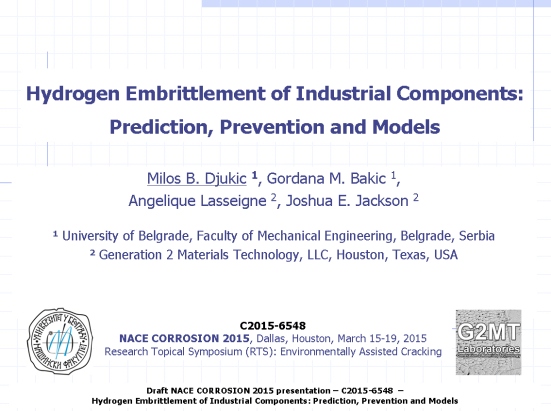Tags
Damage Mechanisms, High Temperature Hydrogen Attack, Hydrogen Embrittlement, Hydrogen Embrittlement Mechanism, Hydrogen Enhanced Decohesion (HEDE), Hydrogen-Enhanced Local Plasticity (HELP), Materials, Materials Characterization, Materials Science, Mechanical Properties, Power Plants
This lecture will be presented by Milos B. Djukic and Angelique Lasseigne at the upcoming NACE International CORROSION 2015 Conference, Dallas, USA, March 15-19, 2015 – Research Topical Symposium (RTS): “Environmentally Assisted Cracking”
Invited lecture schedule: Wednesday, March 18, 2015, 2:45-3:30 pm, Kay Bailey Hutchison Convention Center, Room 172, Dallas
Hydrogen Embrittlement of Industrial Components: Prediction, Prevention and Models
By: Milos B. Djukic 1 Gordana M. Bakic 1, Angelique Lasseigne 2, Joshua E. Jackson 2
1 – University of Belgrade, Faculty of Mechanical Engineering, Belgrade, Serbia
2 – Generation 2 Materials Technology, LLC, Houston, Texas, USA
Corrosion 2015 -Final Program, see page 57 for some more details about this lecture:
http://corrosionfp.epubxp.com/i/477937-2015/163
Abstract
Hydrogen embrittlement is a common, dangerous, and poorly understood cause of failure in many metal alloys. In practice, it is observed that different types of damages to industrial components have been tied to the presence and localization of hydrogen in metals. Many efforts have been made at understanding the effects of hydrogen on materials, resulting in an abundance of theoretical models and papers. However, a fully developed and practically-applicable predictive physical model still does not exist industrially for predicting and preventing hydrogen embrittlement. The connection of microstructure-based behaviors of materials and effects on the macroscopic measurable characteristics (stress levels, hardness, strength and impact toughness) is of the utmost importance to achieve a unified model for hydrogen embrittlement. This paper gives an overview of the application of model for structural integrity analysis of boiler tubes made of plain carbon steel exposed during operation to a local corrosion process and multiple hydrogen-assisted degradation processes: hydrogen embrittlement (HE) and high temperature hydrogen attack (HTHA). The model is based on the correlation of mechanical properties to scanning electron microscopy fractography analysis of fracture surfaces in the presence of simultaneously active hydrogen embrittlement micro-mechanisms. The proposed model is practical for use as a predictive maintenance in power plants, since it is based on the use of standard macro mechanical tests. In addition, this paper will review new non-destructive electromagnetic sensors being designed to measure very early stages of HTHA and HE by measuring the increase in residual stress associated with the presence of the hydrogen atoms. Together the predictive maintenance models and NDE tools combined will allow for practical determination of the extent of hydrogen damage and calculation of the remaining life with much greater accuracy than existing practices. 


Milos, I am sure this conference and your presentation there would bring an enormous success to your career. I am very hopeful that the model you are going to present will prove to be the base for settling this Hydrogen embrittlement issue. Best of luck!
LikeLiked by 1 person
Thank you very much Qamar!
LikeLike
Thank you Claudio.
LikeLike
Reblogged this on cgschoen and commented:
Recommended
LikeLiked by 1 person
Dear Jerry, Thank you very much. I would be very pleased to meet you finally. I hope there will be opportunities. Best Regards, Milos
LikeLike
Anxious to hopefully see a copy of this slide presentation after you have presented it live. I wish that I could be there in person to hear your talk. Best of luck! – Jerry
LikeLiked by 1 person